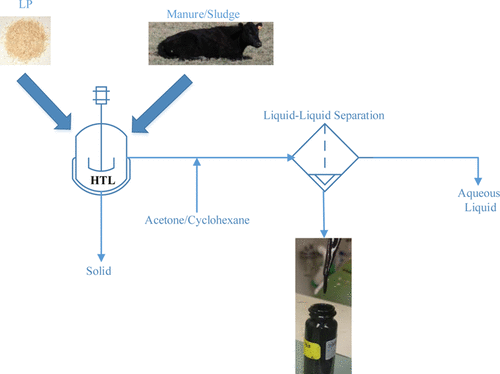Our official English website, www.x-mol.net, welcomes your
feedback! (Note: you will need to create a separate account there.)
Hydrothermal Liquefaction of Loblolly Pine: Effects of Various Wastes on Produced Biocrude
ACS Omega ( IF 3.7 ) Pub Date : 2018-03-14 00:00:00 , DOI: 10.1021/acsomega.8b00045 Akbar Saba 1, 2 , Brandon Lopez 3 , Joan G. Lynam 4 , M. Toufiq Reza 1, 2
ACS Omega ( IF 3.7 ) Pub Date : 2018-03-14 00:00:00 , DOI: 10.1021/acsomega.8b00045 Akbar Saba 1, 2 , Brandon Lopez 3 , Joan G. Lynam 4 , M. Toufiq Reza 1, 2
Affiliation

|
In this study, feedstock interaction of cow manure and digested sewage sludge on hydrothermal liquefaction (HTL) of loblolly pine (LP) was evaluated. Noncatalytic HTL experiments were performed at reaction temperatures of 250, 275, and 300 °C at a constant reaction time of 30 min. Cyclohexane and acetone were used for biocrude extraction separately. The study focuses on the characteristics of the produced biocrude, and thus, physicochemical properties of biocrudes were examined by gas chromatography–mass spectrometry, Fourier-transform infrared spectroscopy, density, and viscosity measurements, in addition to comparing mass and energy yields. On a LP basis, the biocrude yield reached as high as 30 and 17% for acetone and cyclohexane extraction, respectively, at the highest reaction temperature. Elemental carbon and energy contents increased with increasing HTL temperature for all cases. Alkalinity of the HTL process liquid (aqueous phase) increases from the HTL of sludge, and thus, it favored the formation of nonpolar compounds in biocrude. On the other hand, acidity of the reaction medium increases with the HTL of manure and pine, and thus, phenolic compounds in biocrude were increasing. Cyclohexane was more effective for sludge/LP biocrude extraction, whereas acetone was effective for manure/LP. Density of cyclohexane extracted sludge/LP biocrudes at 300 °C was less than 1000 kg m–3, whereas acetone-extracted biocrudes had densities greater than 1000 kg m–3. For all the biocrudes, viscosity was reduced considerably for the mixtures when compared to biocrudes from LP alone.
中文翻译:

火炬松的水热液化:各种废物对生产的生物原油的影响
在这项研究中,评估了牛粪和消化污泥的原料相互作用对火炬松(LP)的水热液化(HTL)的影响。在250、275和300°C的反应温度下,以30分钟的恒定反应时间进行非催化HTL实验。环己烷和丙酮分别用于生物粗提。该研究着重于生产的生物原油的特性,因此,除了比较质量和能量产率外,还通过气相色谱-质谱,傅立叶变换红外光谱,密度和粘度测量等方法对生物原油的理化性质进行了研究。以LP为基础,在最高反应温度下,丙酮和环己烷萃取的生物粗品收率分别高达30%和17%。在所有情况下,元素碳和能量含量均随着HTL温度的升高而增加。HTL处理液(水相)的碱度比污泥的HTL高,因此有利于生物原油中非极性化合物的形成。另一方面,反应介质的酸度随着粪便和松树的HTL而增加,因此生物原油中的酚类化合物也在增加。环己烷对污泥/ LP生物粗提物更有效,而丙酮对粪便/ LP则更有效。300°C时环己烷提取的污泥/ LP生物粗品的密度小于1000 kg m 反应介质的酸度随粪便和松树的HTL的增加而增加,因此生物原油中的酚类化合物也在增加。环己烷对污泥/ LP生物粗提物更有效,而丙酮对粪便/ LP则更有效。300°C时环己烷提取的污泥/ LP生物粗品的密度小于1000 kg m 反应介质的酸度随粪便和松树的HTL的增加而增加,因此生物原油中的酚类化合物也在增加。环己烷对污泥/ LP生物粗提物更有效,而丙酮对粪便/ LP则更有效。300°C时环己烷提取的污泥/ LP生物粗品的密度小于1000 kg m–3,而丙酮提取的生物原油的密度大于1000 kg m –3。对于所有生物原油,与仅来自LP的生物原油相比,混合物的粘度显着降低。
更新日期:2018-03-14
中文翻译:

火炬松的水热液化:各种废物对生产的生物原油的影响
在这项研究中,评估了牛粪和消化污泥的原料相互作用对火炬松(LP)的水热液化(HTL)的影响。在250、275和300°C的反应温度下,以30分钟的恒定反应时间进行非催化HTL实验。环己烷和丙酮分别用于生物粗提。该研究着重于生产的生物原油的特性,因此,除了比较质量和能量产率外,还通过气相色谱-质谱,傅立叶变换红外光谱,密度和粘度测量等方法对生物原油的理化性质进行了研究。以LP为基础,在最高反应温度下,丙酮和环己烷萃取的生物粗品收率分别高达30%和17%。在所有情况下,元素碳和能量含量均随着HTL温度的升高而增加。HTL处理液(水相)的碱度比污泥的HTL高,因此有利于生物原油中非极性化合物的形成。另一方面,反应介质的酸度随着粪便和松树的HTL而增加,因此生物原油中的酚类化合物也在增加。环己烷对污泥/ LP生物粗提物更有效,而丙酮对粪便/ LP则更有效。300°C时环己烷提取的污泥/ LP生物粗品的密度小于1000 kg m 反应介质的酸度随粪便和松树的HTL的增加而增加,因此生物原油中的酚类化合物也在增加。环己烷对污泥/ LP生物粗提物更有效,而丙酮对粪便/ LP则更有效。300°C时环己烷提取的污泥/ LP生物粗品的密度小于1000 kg m 反应介质的酸度随粪便和松树的HTL的增加而增加,因此生物原油中的酚类化合物也在增加。环己烷对污泥/ LP生物粗提物更有效,而丙酮对粪便/ LP则更有效。300°C时环己烷提取的污泥/ LP生物粗品的密度小于1000 kg m–3,而丙酮提取的生物原油的密度大于1000 kg m –3。对于所有生物原油,与仅来自LP的生物原油相比,混合物的粘度显着降低。











































 京公网安备 11010802027423号
京公网安备 11010802027423号